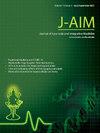Effect of ten-week yoga intervention on problematic smartphone usage in university students: A randomized controlled trial
IF 1.9
Q3 INTEGRATIVE & COMPLEMENTARY MEDICINE
引用次数: 0
Abstract
Background
The rise in problematic smartphone use among university students underscores the potential of yoga, with its evidence-based ability to improve problematic behaviours at their core.
Objective
To determine whether a ten-week yoga intervention can reduce the symptoms of problematic smartphone usage in university students.
Materials & methods
One hundred fifty participants aged between 18 and 23 years were randomly divided into a yoga (n=75) and a control group (n=75) with an allocation ratio of 1:1. The yoga group received yoga intervention for ten-weeks, whereas the control group carried out their normal daily routine. Each participant was assessed for the symptoms of problematic smartphone usage at baseline, post intervention and two months follow-up by using a standardized Problematic Use of Mobile Phone (PUMP) scale.
Results
Data were analyzed using SPSS 24.0. Repeated measure analyses of variance (RM-ANOVA) with baseline PUMP score used as a covariate have shown a significant reduction in overall problematic smartphone usage (p<0.001; Bonferroni adjusted post hoc analyses) in the yoga group after ten-week of yoga intervention and at two months follow-up (p<0.001).
Conclusions
The results suggest that regular practice of yoga may act as a useful approach to reduce the problematic smartphone usage and its associated symptoms in university students.
十周瑜伽干预对大学生智能手机使用问题的影响:一项随机对照试验
大学生中有问题的智能手机使用率的上升凸显了瑜伽的潜力,瑜伽的核心是基于证据的改善问题行为的能力。目的探讨为期10周的瑜伽干预能否减轻大学生智能手机使用问题的症状。材料&方法150名年龄在18 - 23岁之间的参与者随机分为瑜伽组(n=75)和对照组(n=75),分配比例为1:1。瑜伽组接受为期十周的瑜伽干预,而对照组则进行正常的日常生活。每个参与者在基线、干预后和两个月的随访中使用标准化的手机问题使用(PUMP)量表评估智能手机使用问题的症状。结果采用SPSS 24.0软件对数据进行分析。重复测量方差分析(RM-ANOVA),以基线PUMP评分作为协变量,显示瑜伽组在瑜伽干预10周和随访2个月后,总体有问题的智能手机使用显著减少(p<0.001; Bonferroni调整后的事后分析)。结论:研究结果表明,经常练习瑜伽可能是减少大学生智能手机使用问题及其相关症状的有效方法。
本文章由计算机程序翻译,如有差异,请以英文原文为准。
求助全文
约1分钟内获得全文
求助全文
来源期刊

Journal of Ayurveda and Integrative Medicine
INTEGRATIVE & COMPLEMENTARY MEDICINE-
CiteScore
4.70
自引率
12.50%
发文量
136
审稿时长
30 weeks
 求助内容:
求助内容: 应助结果提醒方式:
应助结果提醒方式:


